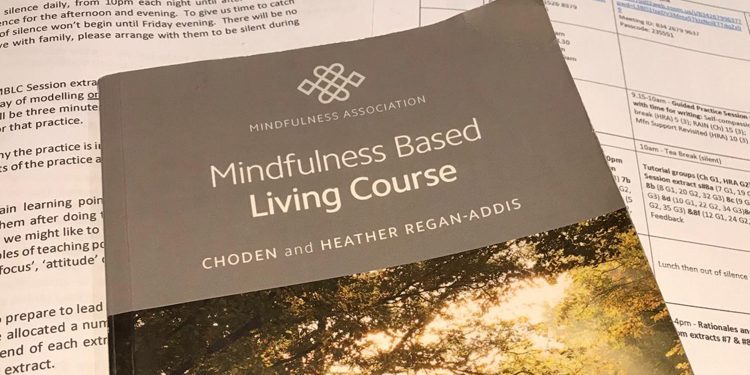This week behind the scenes basics from the MBLC Mindfulness Based Living Course – an overview from the perspective of a trainee teacher i.e. me. (Reluctant and terrified trainee teacher).
There are three ways to qualify as Ready to Teach the MBLC.
A: MIndfulness Level 1 > Teacher Training Level 1 ( 2 weekends) > Teacher Training Level 2 (Retreat) > Ready to Teach MBLC Certificate
B: MSc Studies in Mindfulness with University of Aberdeen Y1 & Y2 (MBLC Level 1) > Continue (with MA) onto Teacher Training Level 2 (Retreat) > Ready to Teach MBLC Certificate
C: MSc Mindfulness & Compassion with University of West of Scotland in London > Ready to Teach Certificates in MBLC & CBLC
To be registered with BAMBA (British Association of Mindfulness Based Approaches) you will need to run 2 x 8 week MBLC courses under supervision.
. . .
My route into the teaching course came kind of by accident on the MSc Studies in Mindfulness, where at the end of each year, there is a chance to undertake the Level 1 Teaching Skills.
This was not too daunting as we sat with our tutor groups for this training, and actually had a bit of a giggle. For example, we quickly learned that if you were at the ‘end’ of the circle, and it was your turn to lead last – then you were a nervous wreck by then and not at all mindful! So I tried to always go near the beginning to get it over with and enjoy the practices.
In order to get on to this Level 1 Teaching Skills Weekend, you need to have completed Level 1 Mindfulness Training. If you have completed Mindfulness Level 2 – Responding with Compassion and INSIGHT courses, this will definitely enrich your skills as a Mindfulness teacher and give you a deeper understanding of the subtle mind processes in yourself and therefore in your participants.
The Mindfulness Association have a selection of Level 1 courses which are either delivered over 4 weekends, OR you can attend weekly sessions.
From the end of August and starting in September there is the possibility of attending morning Mindfulness or evening Mindfulness Level 1 Foundations of Mindfulness sessions. SEE BELOW FOR UPCOMING LEVEL ONE COURSES starting or continuing in August & September.
If you have attended a Foundations of Mindfulness first weekend, then you can hop on to a CONTINUATION COURSE to finish the Level 1 training. I’ll add links below to the specific courses for you if you are interested.
HOW WE LEARN
So to begin the practice sessions are very short and in small groups of three sharing a bodyscan – I start with the whole body – you do the toes and feet – the next person on the ankles etc, – and as our confidence grows so does the group size… moving up to leading a Settling, Grounding, and Resting practice, by passing the baton so to speak, first person – settling into posture, next – intention and motivation – next – focusing on the breath – next etc etc until everyone has had a chance to lead a little. There is no feedback on these early sessions which gives a lot of freedom, alleviates nerves and allows you to just find your way with the practices and to find your own voice. Embodiment is an aspiration at this stage! – difficult when the mind is engaged with thinking what’s coming next and wanting to giggle at times.
These bite sized chunks in relaxed sessions works well. This is followed by enquiry practice – enquiring into the group’s individual experiences – there is definite methodology in this key and integral part of mindfulness training.
We are taught certain language etiquette but encouraged to do it our own way, while sticking to the syllabus. This is important.
At the start it is easy to get confused with the different parts of settling grounding and resting (SGR). It is really, really helpful to download the free MBLC app and just listen over and over to the practices when walking, or my favourite, first thing in the morning for my morning sit and also at bedtime. My app is like my pocket friend. The voices are familiar and it just helps embed the way of speaking and the slow pace of the delivery. Slow and spacious.
Once you have completed the Mindfulness Level 1 and then the Level 1 Teacher Training first weekend you are invited to write an assignment before attending the 2nd weekend. Some people just do the first weekend to add skills to their existing practices. The 2nd weekend is usually around 3 months after the first. The second weekend builds on the first with more leading of longer sessions in slightly larger groups and now with some tutor feedback to guide you. By the time we get to the second weekend we are ready for some tutor and peer feedback.
Once you have attended both weekends you then join the Mindfulness Association as a Trainee Teacher. The trainee teacher membership gives you access to a great library of CPD (Continuing Professional Development) videos and teaching archive and access to regular meet ups on zoom with Heather Regan-Addis who will help you with any questions you may have and also help you to find a peer group of 4 (or more to practice with). You then take yourself through the 8 week course, practicing and journaling every day. You can’t not do this part! The journaling is such a great way to notice process. Tutors will check that you have done this part.
We had about 7 in our peer group as not everyone can attend each session so we were usually 3 or 4 at each session to practice with. I bought zoom (£120) as a way of making sure I did practice! so I took on the role to manage the meetings as I was so keen to keep going. Peer group sessions need to be well managed or it dissolves into chat time, which we all needed actually, but really 2 hours is quite long so if you keep it a little strict about time it prepares you for the Retreat Proper because I tell you, Heather Will Be Watching You with her clock! So each person has 30 mins MAX to lead a little do some enquiry and then have the feedback from the peers about what you smashed! Where you crashed and what was interesting about your session. (Actually “What went well, what could be improved and what was interesting”, or a ‘wild card’, or a ‘tune up’” – these are all terms that appeared during the retreat).
So now we are ready for the Level 2 retreat.
We had been practicing for months and in my previous blogs I wrote about how nervous I was, how difficult it was for me – so much resistance and fear around the idea of ‘teaching’. One way to get through this was for me to really acknowledge the fact that this is facilitating mindfulness. It’s not passing on something from my head to your head, it’s guiding you to have your own experience, and to help you relate to what that means for you. I have nothing to teach anybody in that respect. Only how to have a mindful experience, and even that I cannot guarantee! Your mind is your very own! Connecting with intention and motivation to teach eabled me to connect with WHY. Why am I doing this? This gave me courage in the face of fear.
I was sent lots of documents to read. About 6 weeks before the retreat you are told which practices and talks you will need to lead from the MBLC 8-week course which was devised by Heather Regan-Addis and Choden. Choden is a monk at Samye Ling. Heather and Choden both trained with Psychologist and Buddhist Rob Nairn (who wrote Diamond Mind and several other books which I thoroughly recommend) including from Mindfulness to Insight which all three wrote together. This is the dream team of Compassionate Mindfulness teaching and it was an absolute privilege to be on the course with these truly inspired and inspiring teachers. I am sorry I have never been to a teaching by Rob Nairn but there are a few on the Mindfulness Association’s youtube channel – Rob talks about the psychology of meditation and has a very engaging way of teaching)
The layered way this course has been arranged is just so clever and well thought out. Disciplined structure and groundrules are set, keeping the process safe for everyone. We are invited to consider rationale and teaching points in each session which build on each other creating a truly supportive structure that will help the teacher to hold the space for the participants and help the participants move through the course in a gradual and gentle way. Continuing CPD sessions on enquiry and other topics help to support the continued growth and practice of the teacher.
We had some of our peer group go through the course before us and when they came back they were just in awe of the depth it had added to their practice. It feels soo good to be writing this and I now saying the same thing. This course adds so much in practice as well as to the knowledge of the theory; the Buddhist philosophy, psychology and neuroscientific underpinnings of the course.
Mindfulness training definitely helped me to allow my anxious feelings to be there, feel them, notice how they feel similar to excitement – decide I am actually a bit excited and then do it anyway!
The Retreat lasted 5 days, starting on a Thursday afternoon, and ending on a Wednesday lunchtime. Practice sessions were interspersed with guided practices from the tutors, rationales, and tutor groups, discussion sessions and tea breaks, with long lunchtime breaks. We had 6 in our group but there may be 10.
It’s intense. Exhilirating. Empowering and connecting.
My first session was a 30 minute session. I had to talk on settling the mind for ten minutes, lead a practice for ten minutes and do an enquiry for 10 minutes. Nothing like doing a talk on Settling the Mind to unsettle the mind!
I used an app called flip timer to time the sessions – it’s is a huge flip clock easy to see on my phone and to start and stop.
We all had to do at least two 30 minute sessions and one shorter session. As we had a small group we were all ‘invited’ to lead another 30 minute session. Best to jump in and volunteer to do the ones you fancy!
As the week progressed we had the felt sense of moving down and out of our heads and into our breathing feeling sensing bodies as we let go into embodied guiding as mindfulness teachers. I learned the best way was to throw the notes away and to fully embody the practice as I was leading it. You need to read up on what you are doing so you know it with your thinking mind – but the delivery is embodied, and you just need to trust yourself and your body to deeply know it. Because if you have got this far – trust me – your body knows it. Just Do It.
My second practice was a short Self-Compassion break, that was a lovely one and to finish I had to lead a reflection practice about our journey to becoming teachers of Mindfulness. I had just finished my talk and practice, my last one for the whole course, feeling elated, when lightning struck nearby and my whole house was suddenly plunged into darkness – all the electric went off even the mobile mast was down and so I found myself sitting looking at a black screen, in the dark, nothing to do nowhere to go! The electric was off for 2 hours. I watched myself feeling so cut off from everyone. So alone! The shock abated into feelin ginto this beautiful silent time to really take it all in and feel such gratitude for what I had just achieved and to the tutors for creating such a wonderful deeply moving, helpful, wonderful, authentic course. May we all take this practice and share the benefits of Mindfulness in ever widening circles!
I went and lit the woodburner. Tried to turn the kettle on to make myself a cup of tea (not very mindful haha) and just sat there quietly taking in the good of the whole course.
If you’d like to share your thoughts or have any questions about the teaching please do email me at membership@mindfulnessassociation.net I’d be so happy to hear from you.
Kind and Compassionate wishes,
Lisa Hellier.
Weekly Challenge
The Dalai Lama says that compassion is “the sensitivity to the suffering of self and others, with a deep commitment to try to relieve it”.
After literally going through my resistance to and fear of teaching mindfulness by allowing myself to feel that resistance and be curious about it – that led to me discovering during the retreat that my underlying fears, stemmed from a deep-rooted problem manifesting in many areas of my life as an issue of low self-worth. At the same time I tapped into what it was pulling me towards this course as I was curious about this paradoxical feeling of being torn in two. Compassion. To help others in the way that the Mindfulness Association / Mindfulness & Compassion practices have helped me.
When we allow ourselves to feel and accept our own pain, it transforms into compassion, and we better understand and care about the suffering of others. Compassion gave me courage to face my fears ! (From French word coeur – heart!)
This week I invite you to spend the week using the self-compassion break whenever you notice yourself in a moment of difficulty. Notice what happens as the week goes on. Do you notice any patterns here? Can you feel that you are not alone in your suffering? Just like you, many others are also experiencing these difficult feelings.
Upcoming Courses
UPCOMING LEVEL 1 MINDFULNESS
START HERE: LEVEL 1 (FORTNIGHTLY on Monday Evenings) Starts August 30th
START HERE: LEVEL 1 (Wednesday Mornings) Starts September 22nd
START HERE: FOUNDATIONS OF MINDFULNESS WEEKEND 1 OF 4 – STARTS September 25th
If you have completed a first weekend of Level 1
CONTINUE HERE: LEVEL 1: CONTINUATION (3 x Weekends) August 28th
NEXT TEACHING COURSES:
TRAIN TO TEACH ONLINE LEVEL 1: WEEKEND ONE: 16-17 OCTOBER (& 29-30 January)
TRAIN TO TEACH ONLINE LEVEL 1: WEEKEND ONE – JANUARY 22-23 (& 23-24 April)


